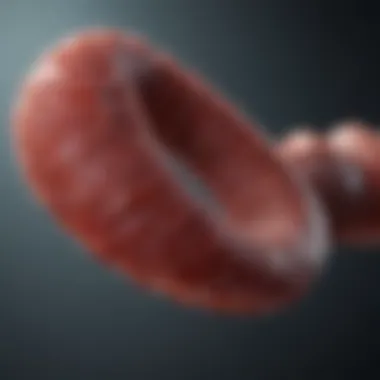Exploring PTX Therapy for Arterial Treatments


Intro
PTX therapy plays an increasingly vital role in vascular medicine. This advanced technique focuses on the treatment of arterial diseases that affect a large segment of the population. Understanding PTX therapy is essential for professionals, students, and researchers interested in the latest advancements in medical practices and treatments.
The significance of PTX therapy lies in its ability to address complex issues within the vascular system. As smoking, poor diet, and sedentary lifestyles contribute to arterial diseases, the medical community needs effective solutions. PTX therapy not only addresses these challenges but also offers improved clinical outcomes, which underlines its relevance in contemporary medicine.
Key Concepts and Terminology
Definition of Key Terms
PTX, or paclitaxel-eluting therapy, involves the use of paclitaxel, a drug initially intended for cancer treatment. In the context of vascular health, it prevents restenosis, which is the re-narrowing of arteries after they have been treated.
Vascular Disease: Refers to conditions affecting blood vessels, including arteries, veins, and capillaries. It encompasses a range of issues that can lead to significant health risks.
Restenosis: This term describes the recurrence of narrowing in a blood vessel after treatment. It is a common complication in patients undergoing various types of vascular interventions.
Concepts Explored in the Article
The article will explore several key concepts:
- Mechanisms of PTX therapy in preventing restenosis.
- Clinical applications and case studies showcasing the effectiveness of PTX therapy.
- Future prospects, including research initiatives aimed at improving delivery systems.
Findings and Discussion
Main Findings
Current studies demonstrate a substantial reduction in restenosis rates through the application of PTX therapy. This therapy has shown promise in both peripheral and coronary artery treatments. The results indicate not only a decrease in re-narrowing but also an enhancement in long-term patient outcomes. Furthermore, ongoing research continues to aim at refining this approach, leading to optimized patient care.
"PTX therapy represents a leap forward in the management of arterial diseases, as evidenced by recent clinical data."
Potential Areas for Future Research
Future research areas could include:
- Developing more effective drug delivery systems to maximize the localized effect of PTX.
- Investigating genetic markers that may predict patient response to PTX therapy.
- Assessing the long-term implications of PTX therapy on overall vascular health.
Through these inquiries, there lies potential for significant advancements in how we approach arterial disease treatments.
Preamble to PTX Therapy
PTX therapy has become a crucial topic in arterial treatment, backed by mounting evidence and clinical interest. Understanding the importance of PTX therapy offers insights into its mechanisms, applications, and future directions in vascular health. This section outlines what PTX therapy entails, its significant historical milestones, and its present relevance in treating arterial conditions.
Definition of PTX Therapy
PTX therapy refers to the use of paclitaxel, an antineoplastic agent originally established for cancer treatment, in managing arterial diseases. This therapy works mainly by inhibiting cell proliferation and regulating cellular processes that lead to vascular complications. By targeting pathways involved in arterial health, PTX can minimize the occurrences of restenosis, a significant issue after vascular interventions such as angioplasty or stenting.
Historical Context
The development of PTX therapy for arterial applications traces back to the 1990s when research revealed paclitaxel's potential benefits beyond oncology. Initial studies demonstrated that systemic administration of paclitaxel could effectively reduce neointimal hyperplasia, a key contributor to restenosis. As clinical trials emerged, paclitaxel-eluting devices began to be tested, leading to breakthrough treatments that significantly improved outcomes for patients undergoing arterial procedures. Over time, PTX has become synonymous with advancements in minimally invasive therapies and has reshaped the landscape of vascular medicine.
Relevance in Modern Medicine
In contemporary medical practice, PTX therapy stands out for its ability to enhance the efficacy of established vascular treatments. Reluctance about potential side effects has persisted, yet studies indicate a leading role for PTX in reducing complications associated with peripheral arterial disease and coronary artery disease. Its accessibility and adaptability prompt medical professionals to reconsider treatment protocols, especially in cases where conventional therapies fall short.


"PTX therapy represents a transformative element in the approach to arterial diseases, providing tailored treatment options for complex cases."
Furthermore, integrating PTX therapy into clinical use addresses not only the need for improved patient outcomes but also aligns with the larger push towards evidence-based medicine. Researchers and practitioners increasingly acknowledge the essential role of PTX therapy in shaping cardiovascular intervention strategies.
This introduction sets the stage for a deeper exploration of PTX therapy, guiding the reader through its mechanisms, applications, and clinical implications.
Mechanisms of Action
Understanding the mechanisms of action of PTX therapy is crucial in appreciation of its role in treating arterial diseases. This section dissects how PTX interacts with biological processes, influencing the outcomes in vascular health. Grasping these mechanisms enables healthcare professionals to advocate for PTX therapy effectively, seeing its potential beyond traditional treatments.
Pharmacodynamics of PTX
Paclitaxel (PTX) exhibits unique pharmacodynamics, defining how it interacts with cellular structures and processes. This chemotherapeutic agent primarily works by affecting microtubules during cell division, preventing the mitotic process. The consequence of this is significant, especially in managing arterial conditions where cell proliferation must be tightly regulated. Moreover, PTX increases the stability of these microtubules, contributing to its anti-inflammatory properties as well. This pharmacodynamic profile makes PTX a valuable resource in vascular therapy, targeting not just proliferation but also inflammation underlying arterial diseases.
Impact on Cellular Processes
Inhibition of Smooth Muscle Proliferation
Inhibition of smooth muscle proliferation is a pivotal aspect of PTX therapy’s mechanism. Smooth muscle cells can proliferate excessively in response to vascular injury, leading to complications such as restenosis. PTX effectively inhibits this unwanted proliferation through its action on the cellular mitotic process. This specific characteristic is pivotal because it addresses a significant contributor to the failures seen in traditional arterial interventions.
The unique feature of this inhibition is its ability to selectively target only the rapidly dividing cells. This specificity makes PTX therapy a beneficial choice in the context of vascular interventions, reducing the likelihood of adverse remodeling of arterial structures. However, it’s essential to consider that while inhibition is favorable, there can also be risks for patients, as overly suppressing smooth muscle activity might lead to adverse effects in vessel healing. Hence, while there are distinct advantages, careful patient monitoring must accompany this treatment.
Endothelial Function Restoration
Endothelial function restoration is another critical aspect enhanced by PTX therapy. Healthy endothelial layers play a vital role in maintaining vascular homeostasis and preventing thrombosis. PTX positively impacts endothelial function by reducing inflammation and encouraging cellular repair. This aspect is particularly relevant after procedures like angioplasty, where endothelial injury is common.
One of the major features of this mechanism is its dual action: PTX not only addresses existing injuries but also helps maintain optimal endothelial function post-treatment. The restoration contributes significantly to long-term vascular health, reducing risks of complications over time. However, like any treatment, this approach has its considerations. The effects of PTX on endothelial cells must be balanced, ensuring that normal cellular activities are not disrupted too severely. Therefore, while PTX holds promise for improving endothelial function, ongoing assessments of patient responses are crucial.
Comparison with Traditional Therapies
When compared to traditional therapies, PTX therapy offers distinct advantages. Conventional methods may not effectively address the underlying mechanisms of arterial issues, frequently resulting in recurrence of disease. PTX, through its mechanisms, provides a more targeted approach.
- Focused Mechanism: PTX specifically targets cellular proliferation and inflammation.
- Reduced Recurrence: Its role in preventing excessive smooth muscle growth leads to lower rates of restenosis.
- Endothelial Support: It actively promotes endothelial recovery, an area often neglected in standard therapies.
However, traditional therapies also have proven effectiveness and established safety profiles. Patient selection is essential to determine whether the introduction of PTX is appropriate relative to existing treatment options. The landscape of arterial disease management is complex, warranting a holistic view when considering PTX in comparison to existing therapies.
In summary, the mechanisms of action of PTX present a considerable evolution in the management of arterial diseases, marking a shift towards more targeted and effective treatment modalities.
Overall, a deeper understanding of these mechanisms enriches the application of PTX in clinical settings, enabling healthcare professionals to make informed decisions when addressing arterial conditions.
Applications of PTX Therapy in Arterial Treatment
The applications of Paclitaxel (PTX) therapy in arterial treatment represent a major stride in vascular medicine. This section will elaborate on its significance, specifically focusing on the treatment of peripheral arterial disease, management of coronary artery disease, and other vascular applications. Understanding how PTX therapy fits within these treatment paradigms is crucial for practitioners and researchers alike.
Treatment of Peripheral Arterial Disease
Peripheral arterial disease (PAD) occurs when arteries that supply blood to the limbs become narrowed or blocked, leading to restricted blood flow. PTX therapy has emerged as a vital tool in managing PAD. The primary mechanism by which PTX is effective involves its ability to inhibit smooth muscle proliferation. This capability helps to maintain lumen patency in affected arteries, reducing the risk of restenosis.
Clinical studies have demonstrated that PTX-eluting devices yield better outcomes compared to traditional angioplasty and stenting methods. One study noted a significant decrease in the need for re-intervention in patients receiving PTX therapy. The long-term benefits are clear: decreased pain and improved mobility for patients suffering from PAD.
Coronary Artery Disease Management
Coronary artery disease (CAD) is a leading cause of morbidity and mortality worldwide. The application of PTX therapy in CAD management, particularly in drug-eluting stents, has transformed treatment protocols. These stents, coated with PTX, release the drug slowly, thus limiting excessive neointimal hyperplasia that can lead to restenosis.
Evidence from clinical trials reveals that patients treated with PTX-eluting stents exhibit improved patency rates compared to those using bare-metal stents. Moreover, the reduction in repeat revascularization procedures highlights PTX's efficacy in the chronic management of CAD. However, careful patient selection and monitoring remain essential to mitigate potential risks associated with stenting.


Other Vascular Applications
Beyond PAD and CAD, PTX therapy also finds utility in various other vascular conditions. Applications include treatment for arteriovenous fistulas in dialysis patients and management of symptomatic claudication. In each case, the pharmacodynamics of PTX lead to improved vascular health.
Emerging studies suggest potential applications in treating complex vascular pathologies, such as chronic limb-threatening ischemia. The consideration of PTX therapy in these diverse contexts emphasizes its versatility and effectiveness. Additionally, continuous research into the various delivery mechanisms remains essential for optimizing outcomes.
"PTX therapy is not just a treatment; it is a paradigm shift in how we approach arterial disease management. Understanding its applications will shape future practices and improve patient care."
In summary, the applications of PTX therapy in arterial treatment are profound and impactful. The ability to limit complications in PAD, enhance coronary disease management, and explore additional vascular implications illustrates PTX’s significant role in modern medicine.
Clinical Outcomes and Effectiveness
Clinical outcomes and effectiveness are critical areas of focus in the context of PTX therapy. Understanding how this therapy translates into measurable results is essential for healthcare professionals and researchers. It allows for an assessment of the therapy's true value in treating arterial diseases. Evaluating clinical outcomes requires a thorough look into various aspects, including patient survival rates, quality of life improvements, and the recurrence of arterial diseases after treatment. These elements are vital for establishing the efficacy of PTX therapy and guiding future clinical practices.
Evidence from Clinical Trials
Clinical trials provide the backbone for assessing PTX therapy's effectiveness. They offer robust evidence regarding its impact on arterial health. Numerous studies have been conducted that investigate various factors related to PTX therapy.
Some of the pivotal findings from clinical trials include:
- Improved Outcomes: Many trials demonstrate that PTX therapy significantly reduces the incidence of restenosis, which is the re-narrowing of blood vessels.
- Comparative Effectiveness: It has been shown that PTX therapy often outperforms traditional therapies in several key metrics.
"Clinical evidence suggests that PTX therapy yields superior results compared to standard treatment protocols, particularly in peripheral arterial disease management."
- Safety Profiles: Trials continue to evaluate the safety of PTX therapy, revealing manageable side effects that are often outweighed by the benefits.
The ongoing collection and analysis of data from clinical trials remains paramount for optimizing PTX therapy protocols and ensuring that best practices emerge from empirical evidence.
Post-Treatment Recovery
Recovery after PTX therapy is crucial for maximizing treatment outcomes. Understanding the post-treatment phase helps to establish appropriate guidelines for patient management. A few important facets of post-treatment recovery include:
- Monitoring and Follow-Up: Regular follow-ups are essential to monitor the patient's recovery and assess any potential complications that may arise post-therapy.
- Rehabilitation Programs: Structured rehabilitation can enhance recovery, improving both physical capabilities and quality of life.
- Patient Education: Informed patients who understand the recovery process are more likely to engage in healthy lifestyle choices, which further promotes recovery.
Enhanced recovery protocols are gaining traction as more data becomes available, allowing healthcare providers to offer tailored recommendations for PTX therapy patients.
Long-Term Efficacy
Long-term efficacy is a critical element that determines the sustained impact of PTX therapy on arterial health. Evaluating this aspect involves looking at outcomes several years after the procedure. Key points related to long-term efficacy are:
- Sustained Patency Rates: Long-term studies show that PTX therapy maintains higher rates of vessel patency compared to other treatment methods, which is crucial for preventing future complications.
- Quality of Life Improvements: Follow-up assessments often reveal that patients report significant improvements in their quality of life long after therapy.
- Onset of Side Effects: Monitoring long-term side effects is as important as observing immediate effectiveness. Data suggests that serious long-term adverse effects remain low.
In summary, the clinical outcomes and effectiveness of PTX therapy underscore its role in contemporary vascular medicine. Continuous research in this field will undoubtedly enhance our understanding and implementation of this promising therapy.
Considerations and Challenges
Understanding the considerations and challenges associated with PTX therapy is crucial for its successful implementation. As this technique gains traction in vascular medicine, clinicians and researchers must navigate various complexities that arise during its application. Recognizing these elements can promote informed decision-making and enhance patient outcomes.
Adverse Effects and Risks
It is essential to acknowledge the potential adverse effects linked to PTX therapy. While the treatment has shown immense promise, certain risks cannot be overlooked. Common adverse effects include:
- Local irritation at the site of administration.
- Systemic reactions, which may include allergic responses.
- Thrombosis, particularly due to improper technique or underlying conditions.


A comprehensive assessment of each patient’s health history is vital. Identifying specific risk factors can help mitigate these adverse effects and ensure safer treatment protocols. With ongoing research, the understanding of these risks continues to evolve, offering insights into potential solutions.
Patient Selection Criteria
The determination of appropriate candidates for PTX therapy is fundamental to its success. Specific patient selection criteria enable practitioners to tailor treatments effectively. Key factors to consider include:
- Disease Severity: Evaluating the extent of arterial disease is critical. Patients with advanced conditions may derive more benefit from PTX therapy compared to those with mild symptoms.
- Comorbidities: Understanding the patient's overall health, including conditions such as diabetes or hypertension, helps assess the safety of treatment.
- Previous Interventions: A patient’s history of previous vascular procedures influences the choice of PTX therapy.
Selecting the right patients maximizes the benefits of PTX therapy while minimizing potential complications. This targeted approach strengthens the overall efficacy of the treatment.
Cost-Effectiveness Analysis
Analyzing the cost-effectiveness of PTX therapy is essential in modern healthcare. As resources are often limited, understanding the financial implications influences treatment decisions. Cost-effectiveness considerations include:
- Direct Costs: These encompass the medication costs, procedure expenses, and required follow-up treatments.
- Indirect Costs: Factors such as lost productivity due to health issues should also be analyzed.
- Long-Term Value: Evaluating the long-term outcomes of PTX therapy can reveal significant savings by preventing complications and reducing the need for more invasive interventions.
More organizations are integrating such analyses into decision-making processes. This trend is likely to shape the future landscape of vascular treatments, as healthcare professionals strive to optimize patient care within fiscal constraints.
Future Directions in PTX Therapy
The future directions in PTX therapy are vital for understanding how this treatment can evolve and improve outcomes for patients with arterial diseases. Each advancement could potentially enhance the effectiveness, safety, and applicability of PTX therapy. This section discusses key areas of progress that may shape the landscape of vascular medicine in the coming years.
Innovations in Drug Delivery Systems
Innovating drug delivery systems can significantly improve the effectiveness of PTX therapy. Traditional methods often rely on systemic delivery, which may lead to suboptimal concentrations at the site of action. New techniques such as localized delivery mechanisms can minimize systemic exposure and increase the concentration of PTX where it is most needed.
Examples include nanotechnology-based carriers or polymer-based drug-eluting devices that can release PTX in a controlled manner. These systems can be strategically designed to respond to cellular environments, allowing for targeted therapy while reducing side effects. Ongoing research in this area holds promise for better therapeutic outcomes and lower risks for patients.
Expanding Indications
As PTX therapy continues to be studied, its indications may expand beyond current applications. Researchers are exploring its use in various vascular conditions that have not yet been fully characterized. Conditions such as restenosis, thrombosis, and certain types of ischemic diseases may benefit from PTX therapy. As clinical evidence accumulates, it may lead to wider acceptance and guidelines for PTX therapy in these diverse settings.
In addition, understanding patient-specific factors can aid in identifying optimal candidates for treatment. This also opens the door for further exploration into combination therapies, which can harness the unique properties of PTX alongside other interventions, potentially leading to superior clinical outcomes.
Potential for Combination Therapies
The potential for combination therapies with PTX presents exciting possibilities in arterial treatment. Combining PTX with other modalities, like angioplasty, stenting, or even other pharmaceuticals, may enhance the overall effectiveness of vascular interventions. For instance, combining PTX with antiplatelet agents could offer a dual strategy that not only prevents restenosis but also minimizes the risk of thromboembolic events.
This approach requires careful investigation into timing, dosage, and interactions between PTX and the additional therapeutic agents. Clinical trials will play a crucial role in understanding and validating the synergistic effects of these combinations. Emerging data may pave the way for new treatment protocols and improve patient-centric care in vascular health.
The future of PTX therapy depends on multi-faceted innovations that can address current limitations and broaden its clinical utility.
Ending
The conclusion serves as a vital component in any comprehensive exploration of PTX therapy for arterial treatment. It encapsulates the significance of the findings and offers insights into the potential developments of this advanced therapeutic approach. Here, we will summarize key elements that shape PTX therapy's impact in vascular medicine.
Summary of Key Points
PTX therapy has showcased its effectiveness in addressing various arterial diseases, primarily through its mechanisms of action that inhibit smooth muscle proliferation and restore endothelial function. The therapy is applied in treating conditions such as peripheral arterial disease and coronary artery disease. It highlights the promising clinical outcomes validated by extensive research, demonstrating reduced restenosis rates and improved patient recovery.
Additionally, considerations surrounding patient selection, adversse effects, and cost-effectiveness emphasize the need for a tailored approach in clinical practice. The innovation in drug delivery systems and expansion of treatment indications suggest a bright future for PTX therapy as further studies unfold.
Implications for Future Research
Future research must focus on expanding the knowledge surrounding PTX therapy, particularly in determining optimal patient profiles for the best outcomes. There might be significant benefits from combining PTX with other therapies, possibly enhancing efficacy. New technologies in drug delivery can be explored to improve treatment adherence and patient outcomes.
Overall, continued investigation is essential to refine therapeutic strategies and enhance arterial health management. \
"Understanding the potential of PTX therapy can not only improve clinical practices but also provide patients with better health outcomes."
This essential pathway of research holds the promise to innovate current treatments, producing effective interventions that address unmet medical needs in vascular health.







